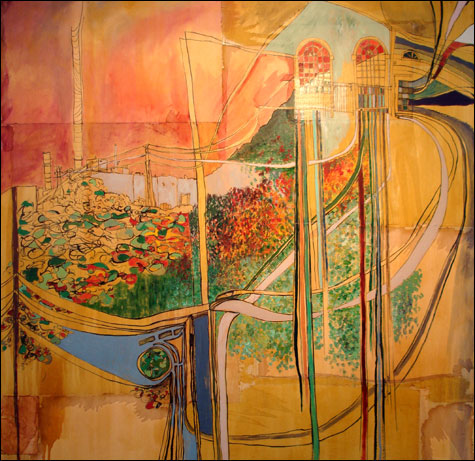Sara Crall's expert hand is on show at Franklin Street Art Space
By IAN PAIGE | November 19, 2008

COLLIDING PSYCHEDELIA "EMF," by Sara Crall. |
Viewing Sara Crall's new show, "observations of," at Franklin Street Art Space in Biddeford is like listening to a musician interpret her own song. The basic composition remains the same, but each entry is an attempt to interpret the moment and, with Crall, that means recognizing a sense of place. She paints massive, sprawling landscapes rendered ephemeral by a delicate hand. Place is both internal and external, a diagram of memory and mirror of the soul or staircase to the heart.Crall's compositions begin with torn paper applied to panel. The background assumes an air of tannin-stained antique or yellowing newsprint. Overlapping paper forms a pattern of texture already pleasing before further content is amassed. The non-uniform shapes in the background serve as a jumping off point for Crall's architecture of the mind. Paint is diluted but deliberate. A Fauvist palette demarcates natural spaces, then is neutered in brilliance to depict the fade into memory and the constructed spaces of humanity. Delicate lines lead the eye down an imperfect path to the next scene. The work is quick but cared for and the artist strikes a chord where mastered composition and a free, impressionable approach are in harmony.
"And the place was no more" speaks to the artist's sense of place by raising the question of its absence. The exterior of a small house in the lower left gently rises into an interior scene in the upper half of the composition by gliding up the trunk of a handsomely gestural tree losing its leaves. Inside, loosely associated scenes of dishes, drawers, and light fixtures become more anecdote than artifact. There is no doubt that this is a house, but is it any longer a place? A hint of melancholy in the memory is inferred with Crall's muted palette and sets the tone for the show as a whole. Place, as distinct from location, is both where you are and how you observe it.
Crall's theme is subject to mandate in "climb the stairs to the island in my heart." A staircase curves into a blue green sea and a boat glides by a Technicolor barricade. Energy emanates from the hidden well like a hot spring while mechanical contraptions, part high-voltage towers and part dream-catchers, spring up in playful spatial relation reminiscent of a world equally that of Dr. Seuss and Juan Miró. The landscape leans emotively and imbalance is accentuated within forms, then in turn relieved by compositional choices that frame the entire work.
At the foot of the stairs, a mannequin (a very prevalent motif for the artist) and miniature still-life painting hung on an invisible wall are more tightly and vividly rendered than anything else in the piece. Paint is applied thickly at this initial point, but as we climb the stairs toward this place of the heart, the long sightlines of landscape become representative of internal states while the paint spreads out emotionally in washes and gentle drips.
Architectural interpretation gives way to greater spatial distortions in "work related." The artist seems to depict a path of experience rather than a landscape. This dock is tied to that deck by a wispy thread of paint, perhaps an active symbol of the details jettisoned by memory in the process of recollection. The result is a convoluted compression of forms, given more meaning in the absence of what is not "related."
 Topics
Topics:
Museum And Gallery
, Dr. Seuss, Sara Crall, Sara Crall, More  , Dr. Seuss, Sara Crall, Sara Crall, Sara Crall, Less
, Dr. Seuss, Sara Crall, Sara Crall, Sara Crall, Less 